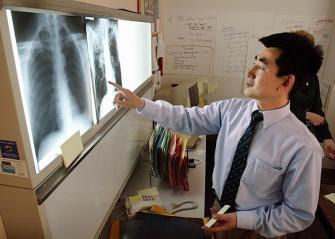The following is written by Lindsay Bosslet for Public Health Insider:
Tuberculosis (TB) has been around thousands of years, and it is one of the most well documented infectious diseases. But, despite treatment being available, in 2014 WHO declared TB the most deadly infectious disease.
According to the Centers for Disease Control and Prevention, we saw an increase in TB in the United States for the first time in 23 years. In King County, TB isn’t increasing, but our proportion of TB-infected individuals (those who carry a dormant form of TB (“latently-infected”)) is higher than Washington’s or any other region in the state. We still have a lot of work to do to make sure latently-infected individuals do not get sick from TB in the future.
In honor of World TB Day, Public Health Insider sat down with Dr. Masa Narita, Disease Control Officer for our TB control program.
PHI: What does TB look like in King County? Is it a serious problem?
In King County, an average of two people is diagnosed with active TB every week, and about 100,000 people are currently latently-infected in our county. We have been able to keep TB under control in our region, but it continues to affect some of the most vulnerable people in this community.
PHI: Who has TB disease?
According to data from 2015, about 80 percent of the people with TB in King County were born outside of the United States. Additionally, as many as 15 percent of TB patients have diabetes and approximately three percent are infected with HIV. And, while we have been able to contain a large TB outbreak among people experiencing homelessness, we need to be diligent to prevent another wave of resurgence. Pre-existing health conditions, socioeconomic factors, and cultural challenges make it harder to access healthcare and get the help needed to treat the disease.
PHI: So what are you doing to make things easier for those who need treatment?
People often need 6 to 9 months of TB treatment, though it may be extended to 18 – 24 months for drug-resistant cases. It is the national and international standard to provide directly observed therapy (DOT), in which we watch patients swallow their medication. This practice insures cure of the disease, prevents development of drug resistance, and stops the disease’s spread.
Our staff visit patients at their homes and workplaces, and other patients come to our clinic. But, this system is not convenient for everyone, so we’ve created alternatives. For instance, we use video conferencing and web-based applications to observe via video. Technology helps us meet people where they’re at and prevents treatment from interfering with day-to-day routines.
PHI: Is the elimination of TB something we can work toward?
Elimination is a major initiative at the global and consequently, the national, state and local, level.
But, TB is a complex disease. Most people infected with TB have latent TB, which isn’t contagious. However, these people are still at risk for TB disease (or “active TB”), so it is important for them to receive treatment. Once TB becomes active, it can be spread from person-to-person through the air.
We also need to continue to identify and evaluate those who were exposed to an infectious TB case through a process called contact investigation. In many cases, we work to figure out who may have been in contact with those with active TB – and then we test and treat those people as needed. These investigations and interventions can take several months and require skilled public health workers, yet resources for TB control have been reduced.
Bottom line: Despite dwindling dollars, we need to work harder, smarter and more collaboratively to get people tested and treated, and to reach out to the most vulnerable populations who are disproportionately affected by this disease.
For more information about the TB program, visit us on the web.


